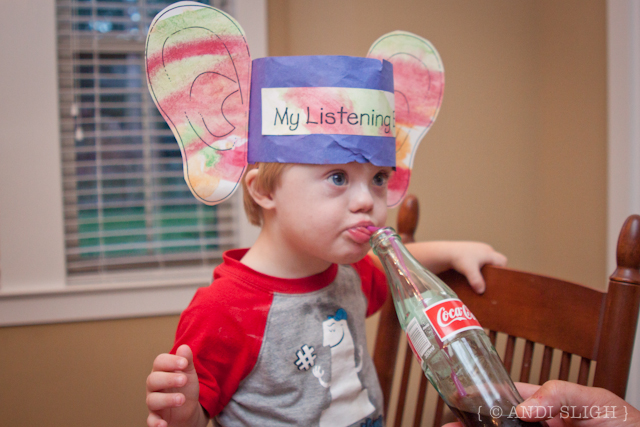
This October I’m opening up the floor to reader questions as part of my contribution to Down Syndrome Awareness Month. As long as you keep it clean, nothing is off limits – Down syndrome, cerebral palsy, birth stories, parenting, photography. What do you want to know? Find the first three Q&A posts here; two more questions with answers are below.
I was interested in a little more information on your daughter’s prematurity. My daughter was born 14 weeks premature and we are going through some things at this stage in the game. Natalee is seven months old. Any information/thoughts/suggestions you may have would be helpful.
Sarah Kate was born ten weeks premature due to an abrupted placenta with no known cause. She was small for her gestational age (only 2 lbs 9 oz – average for that stage is about 4 lbs) but otherwise had a fairly uneventful NICU run. She was never on a ventilator, using a CPAP and an oxygen hood only briefly the afternoon of the day she was born. It was determined that she did have a brain bleed, but it was a Grade 1 and not considered serious. She struggled initially to retain food, and then to gain weight. She was hospitalized for 53 days and was anemic at release but was not treated and recovered on her own (she never had any transfusions).
At the time of Sarah Kate’s release, the neonatal physical therapist gave us exercises to perform with her legs, citing only that they were “tight.” No one indicated to us at that time that the tightness could be cerebral palsy or even that it might be permanent. She was discharged weighing 3 lbs, 14 oz with a high calorie formula supplement.
Between six and nine months of age, she began missing milestones. Her pediatrician wasn’t concerned that she wasn’t sitting at six months, since she was less than four months adjusted, but at her nine month checkup it was a different story. It was at that time that she was referred to early intervention and to a neurologist and orthopedist.
The best recommendation I can give you is that if something bothers you in your gut, get it checked out. Yes, you might be labeled the troublesome parent at the pediatrician’s office, but if Natalee has any health issues or delays, it’s best to start interventions as early as possible, and oftentimes it takes months to get in to see specialists, even if you have a referral. Sarah Kate’s neurologist commented the first time we saw her about how glad she was that the pediatrician had referred her early – that many of them take a “wait and see” approach that wastes precious time.
Which brings me to the next question on the list…
What specialty doctors does Sarah Kate see? I feel like our list of doctors is never-ending! Specifically, I am curious to know if she is followed by an orthopedist. Our daughter is much younger and more “involved” than Sarah Kate, but I just never see you write about doctor appointments (like neurology, orthopedist, opthalmology…etc.). Our daughter, Tennyson, will have hip surgery in a week and a half to have her adductor and hamstrings cut 🙁 Has Sarah Kate ever had hip problems?
We’ve been lucky in that Sarah Kate’s special needs are limited to spastic diplegia. Although she was a small-for-her-gestational-age preemie, she has never had problems with vision or hearing, seizures, or any of the other issues common to kids with cerebral palsy. In fact, she’s much healthier and gets sick a lot less often than I do! She saw a couple of specialists as follow-up to being premature, then none until she was referred at nine months to an orthopedist and a neurologist. The neurologist sent her to spasticity clinic where she was evaluated by a neurosurgeon, orthopedist, physiatrist, and a physical therapist working as a team to make recommendations for her treatment.
The spasticity clinic team recommended selective dorsal rhizotomy (SDR) surgery for Sarah Kate, which she had done a week after she turned three (remember what I said above about referrals – it took just over two years for us to get from the pediatrician to a surgery date). For those that aren’t familiar with SDR, it’s the only surgical option currently available that permanently reduces spasticity – all other surgical options are orthopedic and are meant to be corrective only. You can read more about our SDR experience here.
We still see the orthopedist and/or the physiatrist at regular intervals, but only about once a year – typically when the physical therapist suggests that “it’s time” to go in again. The last time we went the orthopedist didn’t feel surgery was warranted (yet), so we are in a holding pattern for a while longer. If she does have surgery at some point, it will more than likely be a heel cord release. We have not seen the neurologist since before the SDR or the neurosurgeon since her surgical follow up.
Since the SDR, Sarah Kate has had several rounds of Botox and one round of serial casting, but no other surgical procedures. The last time she had Botox, it was much less effective than it had been previously, which is typical – it becomes less effective the more it’s used. The main purpose of the Botox was to reduce spasticity for a few months so that she could work hard in PT and “push through to the next level.” We are out of Botox options at this point. Another possibility is the use of either oral or intrathecal baclofen. She used oral baclofen before her SDR and it’s kind of a scary medication. The intrathecal version would, arguably, be more effective, but implanting a pump in your body is more risky than taking a syringe of medication, so…I’m wary.
So the short answer is that we’ve seen a lot of specialists, we just aren’t seeing that many right now.
UPDATE (12/6/2014): In 2014, things went off the rails. We’re back with a neurologist and she had a major orthopedic surgery cocktail.
Next Up: Making Eye Contact and Sarah Kate Answers a Reader’s Questions
Now it’s your turn. What do you want to know?
You can leave a comment, send an email or use my contact form, or go completely anonymous by dropping your question in the form below.
